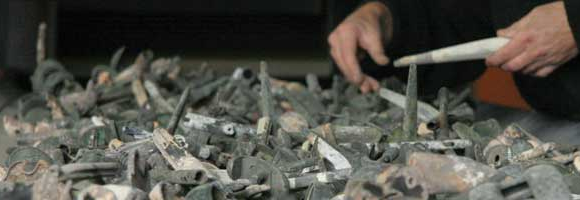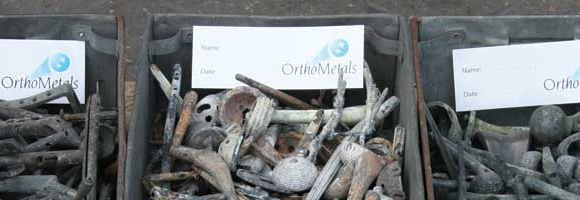orthometals

Some weeks ago we went swimming at the ‘↑Müllersches Volksbad,’ Munich’s gorgeous Art Nouveau indoor pool facility. After having swum some lanes I took a respite in the shallow part of the pool. I hadn’t been swimming for months and may have overdone it a bit on the first lanes. Feeling a slight dragging pain in my right shoulder, I hovered in the water, admiring the architecture, and rubbed said shoulder cautiously.
Submerged to his knees an elderly gentleman smiled fatherly at me from the stone steps leading into the pool.
‘Got one, too?’ he asked in conspirational manner.
‘Beg your pardon, Sir?’ was the only thing I could say. [He wasn’t using the correct word code, and I do not conspire without it.]
He explained that he suspected that I had an artificial shoulder—because he had two of those and was here for exercising them.
Some weeks later, while riding the tramway in the evening, we made the chance acquaintance of an elderly lady. It turned out that, like us, she was on her way to the Völkerkundemuseum, to attend the opening of the ↑EthnoFilmFest. Hence we took the short walk from the tramway stop to the museum together. I noticed that she carried a quite bulgy bag, and seemingly had some trouble with it. So I offered to carry it for her.
‘Ah, no, no, thank you,’ came the reply, ‘I am always walking a bit funny like that. It’s because just a while ago I got my second artificial hip.’
They’re all around us.
The observations stuck, but I only had the usual associations of the hardcore cyberpunk aficionado. Our neighbours the cyborgs—I, cyborg …
Some years ago, when I had problems with a slipped disk and surgery was unavoidedly indicated, I had to wait a bit in the specialist’s anteroom. From the coffee table I picked up a glossy magazine and found a story on a feat the wizards at a clinic in Murnau, Austria recently had achieved. A young woman had a severe paragliding accident and several of her vertebrae were crushed to pieces. The wizards removed the debris and substituted the destroyed vertebrae by custom-made titanium ones, leaving the spinal chord not only intact, but now perfectly protected.
When my surgeon came to usher me into his office, I pointed on the fine computer imagery of the wonder in titanium, and said: ‘That’s what I want!’ Frankly, up to date I do not know if it was in earnest or tongue-in-cheek.
‘You don’t need that at all,’ he replied, ‘I’m not going to put something into you, but will remove just a tiny bit of organic material.’
‘Yeah,’ I thought, ‘and then ↑Tyler Durden makes soap of it.’
Despite this association I not at all thought about the material consequences of prosthetics’ proliferation. Until I stumbled over a recent ↑AP-story at Business Insider on the Netherlands-based company ↑OrthoMetals, which ‘is dedicated to providing an environment-friendly turnkey solution to the collection and recycling of orthopedic implants and other metal remains from crematoria. […] The complete recycling process is under the supervision and control of OrthoMetals. All collected metals are first sorted and then re-melted to prevent the end product from being recognized and re-used as an implant. OrthoMetals is active in over 15 countries serving over 375 crematoria.’
OrthoMetals recovers about 200 tons of valuable metals per year. ‘After deducting costs, including transportation and the salaries for six workers, the proceeds are returned to the crematoria or to national burial associations, to be donated to charities of their choice, said Verberne [OrthoMetals’ director]. Usually the funds go to cancer societies, research institutions or any other medical facilities.’

UPDATE (23 February 2012):
Since two days ago the BBC now carries a story on OrthoMetals, too: ↑Melting down hips and knees: The afterlife of implants. [Btw, I was almost three months faster than ↑Cory Doctorow at boingboing ;-]

